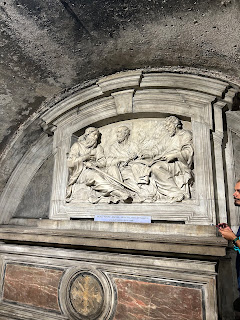Photos to capture and share our mission experience to the Rome Italy Temple with you!
Friday, August 25, 2023
Friends in the Mission Field
14 Beautiful and Special Acres
Four major buildings surround a traditional Italian piazza. In this image you can see the Temple, Patron Housing (square building to the left of the temple), Visitor Center (directly opposite the temple) and Chapel (to the right of the temple). Mingled among the olive trees (400-500 years old), palm trees, fountains and stone planter boxes filled with flowers, are multiple piazettas with stone benches for quiet moments.We just had to save and share this really cool aerial view (screen shot) of the buildings of the Rome Temple Complex. It is a beautiful and peaceful space. We feel blessed and honored to be there every day.
"A temple of God is the most sacred place of worship in the world - a place where heaven touches the earth, a place where marvelous blessings are bestowed, and a place where we can feel closer to our Heavenly Father and Jesus Christ as we strive to become more like Them."
Thursday, August 24, 2023
Appreciating the Apostle Paul
Remnants of frescoes that had once decorated the walls of the apartment, believed to be 8th-century...
Large limestone foundation stones...
A 17th-century altar on higher ground topped with a marble relief showing Peter and Paul reminiscing while Luke listens...
One could easily imagine Paul contemplating his own, inevitable martyrdom from this view as he writes, 2 Timothy 4: "I am now ready to be offered, and the time of my departure is at hand. I have fought a good fight, I have finished my course, I have kept the faith. Henceforth there is laid up for me a crown of righteousness, which the Lord, the righteous judge, shall give me at that day: and not only to me only, but unto all them also that love [him]."
https://www.matthewcowden.com/2016/10/23/pauls-house-arrest-apartments-discovered/
Tuesday, August 15, 2023
Castel Sant'Angelo
Our visit to this unique structure enabled us to to retrace the entire history of Rome, the "Eternal City", all in one place. Famous stories, movies, operas, executions, and historic events took place or were inspired by Castel Sant'Angelo.
(Below is a rendering of what the mausoleum might have looked like.)
View from the top into the courtyard where stacks of cannonballs
waited to be thrown down on attacking armies.
There's the Vatican is in the distance.
The name "Castel Sant'Angelo" is from a medieval legend that in 590 Michael the Archangel appeared before Pope Gregory the Great to announce the end of a plague.
There is his statue, behind us, at the tippy-tippy-top of the castel.
-
Here is another piece of art that captured our heart and soul. We spent a long time admiring this marble sculpture of Jesus. "Christ B...
-
A lovely afternoon/evening walk in Rome took us to Saint Peter's Basilica. It was the perfect day and time to avoid the typical crowds....
-
The Visitors Center at the Rome Temple is decorated for Christmas. There are several traditional Christmas trees and lights but the most am...























